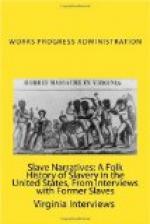MONTGOMERY CO. (Gladys Robertson)
In this community most of the slaves were kept on farms and each family was given a well constructed log house. They were fed by provisions given them by their white masters and they were plentiful. They were clothed by their masters. These clothes were made by the colored women under the direction and supervision of their mistress, the white woman cut the clothes for both men and women, and the colored women did the sewing of the garments. The men did the manual labor on the farm and the women the domestic. Each white woman and girl had a special servant for her own use and care and each white man had his colored man or valet.
There are no records of a big slave trade in this county. When a slave was sold it was usually to a friend or neighbor and most masters were very considerate and would not sell unless a family could go together. For instance from the diary of Mrs. Wliza[TR: Eliza?] Magowan 1853-1871, we read this: “Lina and two children Scott and Dulcina sold to J. Wilkerson”. Also another item: “Violet married to Dennie” showing that care was taken that marriages were made among the negroes.
The darkies had suppers in their own quarters and had much merrymaking and laughter.
Illness among the darkies were cared from among themselves but under the watchful eye of the master and mistress.
The darkies were deeply religious and learned much of the Bible from devout mistresses who felt it their holy duty to teach these ignorant people the word of God. An extract from Mrs. Magowan’s diary on July 25, 1856: “Old Aunt Becky was baptised on the 20th; she being upwards of 70 years of age. A considerable interest on the subject of religion is manifest among the negroes, several have joined may they be kept by the power of God unto Salvation. The redemption of the soul is precious”. This is quoted to show that the Negro was considered as a human being and treated as such.
Also taken from Mrs. Magowan’s diary: “Dove sold to Mr. Van Thompson. O slavery, thorn art a bitter draught! tho’ thousands have tasted of thee, thou art none the less bitter.”
The Underground Railroad did not run through this county. No slaves were carried away on any such thing. The older people interviewed about this say they do not believe such a railroad ever existed as it would be a feat of engineering even in this day and time.
The rosters of the Independent company which Ge. John S. Williams organized in this county and led to Mexico is in the possession of his grandson Mr. John S.W. Hollaway, Winchester, Kentucky.




